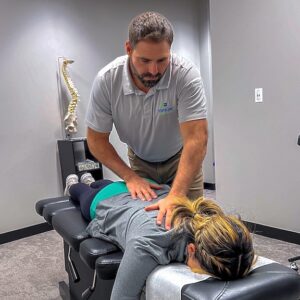Soft wave therapy has emerged as a groundbreaking approach in the realm of chiropractic care, offering a non-invasive yet highly effective method to address various musculoskeletal issues. As chiropractic services continue to evolve, the incorporation of soft wave therapy has become essential for practitioners like Evolve Chiropractic of Schaumburg, Illinois.
Understanding Soft Wave Therapy
Soft wave therapy, also known as extracorporeal pulse activation technology (EPAT) or shockwave therapy, utilizes acoustic waves to stimulate the body’s natural healing process. This non-invasive treatment has gained traction within chiropractic services due to its ability to alleviate pain and promote tissue regeneration.
The Role of Soft Wave Therapy in Chiropractic Care
Complementing Traditional Chiropractic Techniques
Soft wave therapy functions as a complementary modality alongside conventional chiropractic methods. While manual adjustments concentrate on aligning the spine and joints, soft wave therapy targets deeper tissues and areas that might be inaccessible through manual manipulation alone.
This non-invasive therapy harnesses acoustic waves to stimulate the body’s natural healing processes at a cellular level. By doing so, it not only facilitates better circulation and reduces inflammation but also initiates tissue repair. This amplifies the overall effectiveness of chiropractic care by expediting the healing process and offering sustained relief from persistent pain.
Addressing Chronic Conditions and Injuries
Soft wave therapy emerges as a particularly potent tool in tackling chronic conditions and injuries that might not respond adequately to conventional chiropractic treatments. Conditions like plantar fasciitis, tennis elbow, rotator cuff injuries, and certain types of back pain find significant relief through the targeted application of soft wave therapy.
In instances where traditional chiropractic adjustments might not fully resolve issues, the incorporation of soft wave therapy serves as a crucial adjunct. Its ability to penetrate deeper tissues aids in resolving underlying problems contributing to chronic pain and restricted mobility.
Advantages in Pain Management and Rehabilitation
The non-invasive nature of soft wave therapy makes it an appealing choice for individuals seeking pain relief without resorting to invasive procedures or extended use of medications. Additionally, its minimal side effects compared to pharmaceutical interventions contribute to its burgeoning popularity within chiropractic care.
More than just masking symptoms, soft wave therapy actively engages in addressing the root cause of discomfort. By accelerating healing, it becomes an invaluable asset in rehabilitation programs aimed at restoring functionality and mobility after injuries or surgeries.
Improved Range of Motion and Flexibility
Soft wave therapy plays a pivotal role in enhancing range of motion and flexibility, especially for individuals dealing with joint stiffness or restricted movement. By targeting deep tissues and promoting healing, this therapy helps to break down scar tissue and adhesions, allowing for increased mobility and flexibility. This aspect is particularly beneficial for athletes or individuals recovering from injuries seeking to regain optimal movement capabilities.
Accelerated Healing for Muscular and Tendon Injuries
When it comes to muscular and tendon injuries, soft wave therapy shines as a catalyst for accelerated healing. Whether it’s addressing a strained muscle or a tendon injury, the targeted application of acoustic waves helps to promote blood flow and stimulate tissue regeneration. This results in quicker recovery times and reduced downtime, enabling individuals to return to their daily activities or sports faster than through conventional treatment methods alone.
Versatility in Treating Various Conditions
Soft wave therapy’s versatility in treating a wide array of conditions is another remarkable aspect. It isn’t limited to a specific set of ailments; rather, it has shown efficacy in addressing diverse issues, including chronic pain syndromes, repetitive stress injuries, and even certain neurological conditions. This versatility underscores its value as a multifaceted treatment option within chiropractic care, catering to a broad spectrum of patients with varying health concerns.
Long-term Benefits and Preventative Care
Beyond providing immediate relief, soft wave therapy offers long-term benefits and plays a role in preventative care. By stimulating the body’s natural healing mechanisms, this therapy aids in strengthening tissues, reducing the likelihood of recurring injuries, and maintaining overall musculoskeletal health. It serves not only as a solution to existing issues but also as a preventive measure to minimize the risk of future problems, promoting sustained wellness.
Advantages of Soft Wave Therapy in Chiropractic Settings
Soft wave therapy, an innovative addition to contemporary chiropractic care, encompasses a spectrum of advantages that profoundly impact patient well-being and recovery. A detailed exploration of its distinct advantages sheds light on the extensive benefits it brings to chiropractic settings:
1. Non-invasive Nature:
Soft wave therapy’s hallmark lies in its non-invasive approach, preserving the body’s tissues without resorting to surgical interventions. This non-surgical aspect makes it a compelling choice for individuals seeking pain relief without the potential risks, complications, or prolonged recovery periods commonly associated with invasive procedures. Patients favor this non-invasive characteristic for its ability to deliver effective treatment without invasive incisions or post-operative complications, ensuring a more comfortable healing process.
2. Minimal Side Effects:
In stark contrast to pharmaceutical interventions, soft wave therapy is notably safer with minimal side effects. Patients undergoing this therapy typically experience minimal discomfort or adverse reactions, making it an attractive option for those seeking natural and low-risk treatment modalities. The absence of significant side effects enhances patient comfort and confidence in the therapy’s safety, fostering trust in its efficacy as a viable pain management solution.
3. Accelerated Healing:
Soft wave therapy’s significant advantage lies in its remarkable ability to accelerate the body’s natural healing processes. By stimulating blood flow and promoting cellular regeneration, this therapy expedites tissue repair. This accelerated healing mechanism holds substantial promise, particularly for individuals dealing with chronic musculoskeletal conditions or recuperating from injuries. The therapy’s ability to hasten recovery minimizes downtime and facilitates a quicker return to daily activities, improving overall quality of life.
4. Targeted Pain Relief:
Integrated seamlessly into chiropractic care, soft wave therapy offers precise and targeted pain relief. Whether addressing chronic back pain, joint discomfort, or specific conditions like plantar fasciitis and tendonitis, the focused acoustic waves effectively alleviate pain at its source. This highly targeted approach significantly contributes to enhanced pain management, allowing patients to experience relief directly at the site of discomfort, thus enhancing their ability to engage in daily activities with reduced discomfort.
5. Complementary to Chiropractic Adjustments:
Soft wave therapy synergistically complements traditional chiropractic adjustments. While adjustments primarily focus on correcting spinal misalignments and enhancing nervous system function, soft wave therapy concentrates on promoting tissue repair and reducing inflammation. This harmonious combination optimizes the overall effectiveness of the care provided, ensuring a more holistic approach to wellness and offering patients a comprehensive treatment plan tailored to their specific needs and goals.
6. Improved Functionality:
Beyond pain relief, soft wave therapy contributes to enhancing functionality. Patients often report an augmented range of motion, increased mobility, and reduced stiffness following treatment sessions. This substantial improvement in functionality translates into a more active and fulfilling lifestyle for individuals managing musculoskeletal issues, empowering them to engage in activities they previously found challenging due to pain or limited mobility.
7. Long-term Benefits:
Soft wave therapy’s impact extends beyond immediate pain relief; its capacity to stimulate the body’s natural healing mechanisms yields enduring benefits. Patients may experience sustained relief and improved physical well-being even after completing a course of therapy sessions. The therapy’s potential for enduring positive outcomes ensures a lasting impact on patients’ lives, enhancing their overall health and well-being over the long term.
8. Versatility in Conditions Treated:
Soft wave therapy boasts exceptional versatility in addressing an extensive array of conditions across the musculoskeletal spectrum. Its efficacy spans sports-related injuries such as tennis elbow or runner’s knee, degenerative joint diseases like osteoarthritis, overuse injuries such as tendonitis, and even chronic pain conditions like fibromyalgia. This remarkable adaptability positions it as a versatile therapeutic option, capable of addressing diverse patient needs and a wide range of musculoskeletal ailments with precision.
9. Enhanced Blood Circulation:
A pivotal benefit of soft wave therapy lies in its capacity to significantly enhance blood circulation in targeted areas. By stimulating blood flow, the therapy amplifies oxygen and nutrient delivery to tissues, expediting healing and cellular regeneration. Improved circulation not only facilitates tissue repair but also contributes to overall systemic health, promoting vitality and aiding in the body’s natural healing processes.
10. Reduction in Scar Tissue:
Soft wave therapy plays a crucial role in breaking down scar tissue, gradually facilitating its absorption by the body. This process aids in restoring tissue elasticity and function while reducing the likelihood of chronic pain or limitations caused by excessive scar tissue formation. As scar tissue diminishes, patients often experience improved flexibility and reduced discomfort, contributing to enhanced mobility and functionality.
11. Minimal Recovery Time:
Distinguished by its minimally invasive nature, soft wave therapy offers patients the advantage of minimal recovery time. Unlike surgical procedures that may entail prolonged rehabilitation, patients typically experience minimal downtime following therapy sessions. This expedited recovery period enables individuals to swiftly return to their regular activities, minimizing disruptions to daily routines and promoting a seamless integration of therapy into their lifestyles.
12. Personalized Treatment Plans:
Chiropractors proficient in soft wave therapy craft personalized treatment plans tailored to each patient’s unique needs. These individualized plans factor in the specific condition being treated, the severity of symptoms, and patient preferences, ensuring a targeted and effective approach to healing and pain relief. This personalized approach enhances treatment efficacy, optimizing outcomes and ensuring patient satisfaction.
13. Long-term Cost-effectiveness:
While the initial costs of soft wave therapy services may vary, its long-term benefits contribute to substantial cost-effectiveness. By addressing the underlying causes of musculoskeletal issues and potentially reducing the necessity for ongoing medication or invasive procedures, patients may experience considerable cost savings over time. This cost-effectiveness, coupled with its efficacy, positions soft wave therapy as a valuable investment in long-term health and well-being.
14. Non-addictive Pain Management:
In an era fraught with concerns about opioid addiction, soft wave therapy emerges as a non-addictive alternative for managing chronic pain. Patients can attain relief without the risks associated with dependency on pain medications, offering a safer and more sustainable pain management solution. Its non-addictive nature provides reassurance to patients seeking effective pain relief without the potential risks of substance dependency.
15. Suitability for Various Age Groups:
Soft wave therapy’s gentle and non-invasive nature renders it suitable for individuals spanning diverse age groups. From children to the elderly, its adaptability ensures that patients of varying ages can benefit from its healing effects without concerns about adverse effects or limitations based on age. This inclusivity makes it a versatile therapeutic option accessible to patients at different stages of life.
16. Improved Sleep and Overall Well-being:
Patients often report substantial improvements in sleep quality following soft wave therapy sessions. Reduced pain and enhanced mobility contribute to better sleep patterns, promoting overall well-being and mental health. By reducing discomfort and stress levels, the therapy fosters a conducive environment for the body to relax, rejuvenate, and recuperate, ultimately enhancing the patient’s quality of life.
The Future of Chiropractic Care with Soft Wave Therapy
As technology continues to advance, the role of soft wave therapy within chiropractic services is expected to expand further. Its proven efficacy in pain management and tissue repair positions it as a pivotal component in promoting overall wellness and recovery.
Evolve Chiropractic of Schaumburg remains dedicated to offering innovative and effective treatments like soft wave therapy, ensuring their patients receive the best possible care.
Soft wave therapy has evolved from a niche treatment to a fundamental aspect of modern chiropractic care. Its ability to complement traditional methods and enhance healing processes makes it an indispensable tool for practitioners like Evolve Chiropractic of Schaumburg, Illinois, in providing comprehensive and effective patient care.
1501 Woodfield Rd Ste 117e, Schaumburg, IL 60173
(847) 648-4931
https://myevolvechiropractor.com/locations/chiropractor-in-schaumburg-illinois





